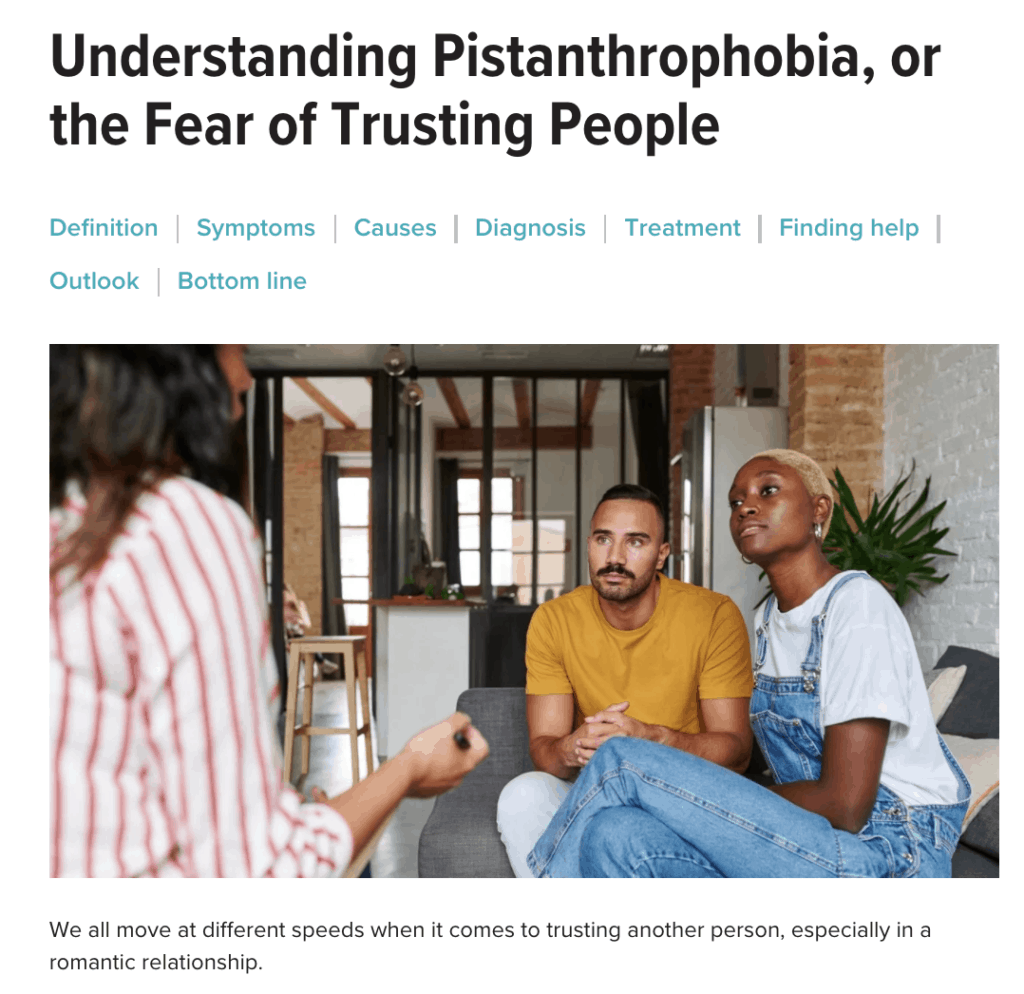- The Indispensable Human Element in Therapy - January 5, 2024
- The Effects Of Eggshell Parenting - August 23, 2023
- Curious Vs Furious - October 20, 2022
Recently I had the absolute pleasure of being interviewed by Healthline for an article on trusting others. Though some are more apt to trust than others, Pistanthrophobia is a little different. As Healthline says, “We all move at different speeds when it comes to trusting another person, especially in a romantic relationship. For some, trust comes easily and quickly, but it can also take a long time to trust someone.”
What is Pistanthrophobia?
“A phobia is a type of anxiety disorder that presents as persistent, irrational, and excessive fear about a person, activity, situation, animal, or object. Often, there’s no real threat or danger, but to avoid any anxiety and distress, someone with a phobia will avoid the triggering person, object, or activity at all costs. Phobias, regardless of the type, can disrupt daily routines, strain relationships, limit the ability to work, and reduce self-esteem. There’s not much research specifically on pistanthrophobia. Rather, it’s considered a specific phobia: a unique phobia related to a specific situation or thing. Specific phobias are quite common. According to the National Institute of Mental Health, an estimated 12.5 percent of Americans will experience a specific phobia in their lifetime,” says Healthline.
Pistanthrophobia is the fear of trusting others and is often the result of experiencing a serious disappointment or painful ending to a prior relationship. As a result of the trauma, the person with this phobia possesses a fear of getting hurt again and avoids being in another relationship as a way to guard against future similar painful experiences. When this happens, you’re unable to have a future relationship that may help you gain perspective or understanding as to why the prior relationship may not have been a good fit to begin with.
What are the Symptoms?
Pistanthrophobia, or any phobia, needs to be diagnosed by a mental health professional.
- avoidance of conversations or deep interactions with a person who could be a potential love interest
- being guarded or withdrawn
- unreceptive to attempts by another person to engage them in flirtation, dating, or romantic relationships
- anxiety or an appearance of wanting to get away or out of conversations that are becoming uncomfortable, especially as they relate to intimacy, dating, or a prospective romantic partner
These behaviors are all considered unsafe to a pisanthrophobe. They are hypervigilant about letting themselves participate in behaviors that have the potential to lead to vulnerability, out of a fear that the connection could lead to a deeper relationship.
Anything that is considered a phobia in the psychology world meets the definition of a diagnosable mental health issue when it interferes with a client’s ability to fully participate in one or more aspects of life. When your personal, professional, or academic worlds are affected by an inability to concentrate, function, or produce normally expected outcomes, you’re considered impaired by the phobia.
Just like we do for clients who have a fear of spiders or heights, we work with a pistanthrophobic client to slowly develop exposure and tolerance to the stimulus they fear. When clinicians work with people with phobias, they often focus on behavior modification as a way to rewire the way a person views or thinks about a particular situation or object associated with fear or catastrophe. The clinician working with a pistanthrophobic client will likely start small by asking them to visualize what it would be like to be in a romantic relationship and encouraging them to talk through the experience with the clinician present.
What should you do?
If this sounds like you or a loved one, glance through Healthline’s article here.
At The Relationship Place, we can help you work through this. Schedule a consultation with us today; there is hope!

